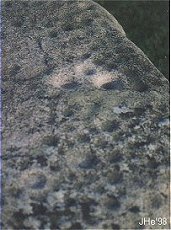insula-moenia.dk

insula-moenia.dk

Between 1700 - 500 BCE bronze got more and more common and finally completely replaced the use of flintstone. Now people buried their dead in big mounds. On Møn alone are about 200 bronze age mounds, 125 of those are smaller ones. The big mounds are from the period between 1.500 - 1.000 BCE and can be found at Klinteskoven, Stubberup Have, Lilleskov and at Fanefjord. These mounds cover a single grave with a coffin made of an oak-tree which was split in the middle and hollowed.
It was also during this period the cupmarks like the ones on Sømarkedysse, Sprove Dysse and Busemarke Dysse were made as a part of a fertility cult which worshipped the sun.
Between 1.000-500 BCE the graves got smaller and people began to cremate their dead and bury them in urns - urn graves. The bones were cleaned before the burial. The burial deposits were few and nothing out of the ordinary. The grave could be encircled by stones and it is not unlikely to find a Bauta-stone near the grave. Bronze age mounds can be found at Klinteskoven, Busene Have with 8 graves and one 1½ m high Bauta-stone (+ a stone circle from the Viking age), and at Hårbølle Hestehave several mounds with border-stones around them have been excavated.
The reason why people began to cremating their dead, and reducing burial deposits, was to prevent the graves from being robbed. Grave-robbery started as a result of a new trait that entered societies about that time: personal possession, accompanied by territorial demarcation and territorial borders. The rich sacrificial offers were safe because they were sunk in mosses.
Sacrifices have become common, mainly at mosses, mostly women´s jewelry and occasionally a man's belonging have been found.

